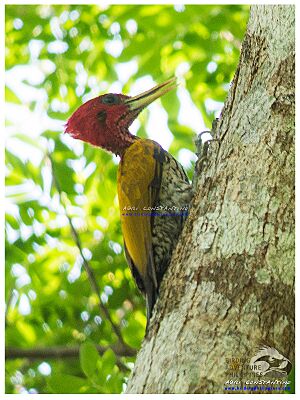Red-headed flameback facts for kids
Quick facts for kids Red-headed flameback |
|
|---|---|
 |
|
| A male on a tree trunk | |
| Conservation status | |
| Scientific classification | |
| Genus: |
Chrysocolaptes
|
| Species: |
erythrocephalus
|
The red-headed flameback (Chrysocolaptes erythrocephalus) is a type of bird in the woodpecker family. It is a very special bird because it lives only in the Philippines. You can find it in the Palawan region, on islands like Balabac, mainland Palawan, Busuanga, and Calamian.
This bird is known for its amazing looks. It has a bright red head and a yellow-green back. It is one of the most colorful flameback birds. Sometimes, people think it is a type of greater flameback. The red-headed flameback lives in wet lowland forests. This includes old forests, newer forests, and even clearings where some trees are still standing. Sadly, its home is shrinking, which puts the bird at risk.
Contents
What Does the Red-headed Flameback Look Like?
This bird is a large and rare woodpecker. It lives in forests and at the edges of forests. It needs places where big trees are still standing.
Colors and Markings
The red-headed flameback has green feathers on its back and wings. Its belly and neck are dark. They have many cream-colored spots and marks. The top of its head has a crest that slopes back. It also has a big black spot near its ear.
Male vs. Female
Males have a bright red head. Females have a red head too, but with orange spots on the top.
How to Tell it Apart
This bird looks a bit like the Spot-throated flameback. But the red-headed flameback has a pale yellow beak. It also does not have the black and white stripes on its head that the Spot-throated flameback has.
What Does it Sound Like?
The red-headed flameback makes a loud, metallic, and fast trilling sound. It also makes loud, squeaky noises that sound like they come from its nose.
Where Does the Red-headed Flameback Live?
This bird lives in both old and new forests. It also lives in clearings that still have many trees. You can usually find these birds in pairs. They have been seen laying eggs and raising young between January and May.
Why is the Red-headed Flameback in Danger?
Experts have said this bird is "near threatened." This means it could become endangered soon. There are only about 1,000 to 2,499 adult birds left.
Main Threats to the Bird
The biggest problem for the red-headed flameback is habitat loss. This means their forest homes are being destroyed. People also hunt these birds.
Forest Loss in Palawan
Many lowland forests in Palawan have been cut down or damaged. This is still happening. Companies have even been given permission to cut down trees and dig for minerals in most of the remaining forests. People are also illegally cutting down trees in the south of Palawan.
How to Help the Red-headed Flameback
To help these birds, scientists suggest a few things:
- They need to study the birds in their homes to count them better.
- They need to figure out how much good forest is left.
- It is important to plant trees carefully around the remaining forests.
- Laws against illegal logging need to be enforced more strictly.



